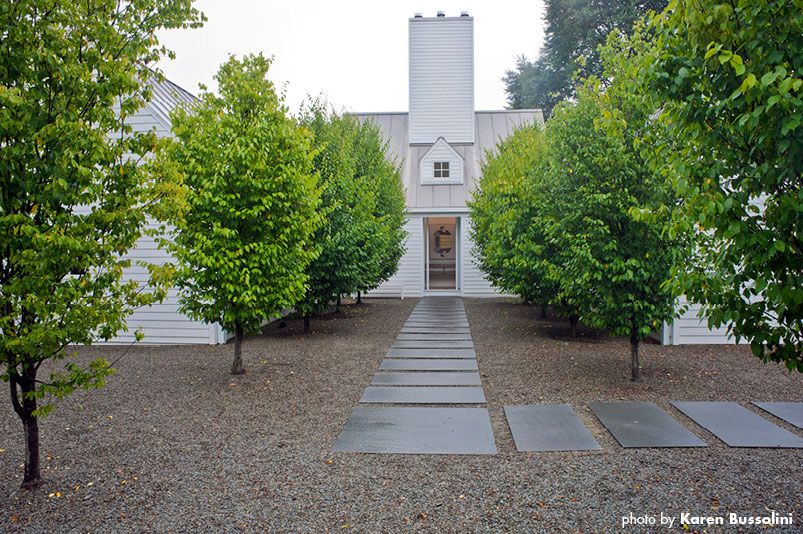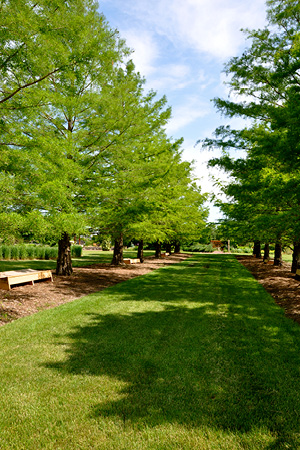Thinking Outside the Box(wood)

An allee of American hornbeams (Carpinus caroliniana) makes for a strikingly minimalist formal landscape in this Pittsburgh, PA garden designed by Jonathan Dreher. The gravel yard is a rainwater collection and storage system. PHOTO Karen Bussolini
PICTURE A FORMAL GARDEN neatly defined by clipped hedges and arranged in perfect symmetry; native plants may not leap to mind. Formal gardeners often rely on traditional exotics like boxwood, privet and roses, leaving native plants to those who prefer naturalistic gardens or wildscapes. Why are native plants readily adopted for one garden style but not the other? After all, plants are plants, and well-chosen natives can shine in formal designs too.
Native plants may be shunned for the common misperception that they look weedy or too wild for a more structured garden. Tradition also plays a role. When boxwood has been used successfully in formal gardens for hundreds of years, it can seem unnecessary, even risky, to try a native shrub instead.
Andrea DeLong-Amaya, director of horticulture at the Wildflower Center, points out, “We’re still experimenting with natives to learn what works well under cultivation and what doesn’t.”
Even so, native plants benefit gardens – and the larger environment – in many ways: by creating habitat for native wildlife, which increasingly depends on the sanctuaries of home gardens; by thriving in local conditions without heavy applications of water or chemicals; and by fostering a strong sense of place. Since there’s no rule saying you must use only traditional exotics for a formal garden, why not update this classic style with a contemporary focus on sustainability?
Take Control

Bald cypress trees (Taxodium distichum) lead to a focal point at Reiman Gardens in Iowa. PHOTO Reiman Gardens – Iowa State University – Ames, Iowa.
To select native plants for a formal garden, it’s helpful to consider what that style emphasizes: balance, repetition, strong lines that lead the eye and a sense of the gardener’s control. The only criteria for selecting a native plant is whether it can be used to achieve these goals. Take hedging, for example, a technique commonly used to define space and create lines as visual guides. Through regular pruning, rows of shrubs – typically boxwood – are turned into space-defining walls and low parterres, as well as topiary balls or pyramids that create rhythm when repeated and symmetry when echoed on each side of a path.
To find a native alternative, consider a plant’s natural form – its three-dimensional shape – and whether it responds well to pruning. Upright native shrubs with dense, small leaves, such as cenizo (Leucophyllum frutescens) and flame acanthus (Anisacanthus quadrifidus var. wrightii), can be good choices for hedging. Plants with a naturally spherical form, such as dwarf yaupon holly (Ilex vomitoria ‘Nana’), can replace traditional ball-shaped topiary with minimal pruning. Surprisingly, even bamboo muhly grass (Muhlenbergia dumosa) can be trimmed into hedge-like form. Imagine a parterre outlined in its shaggy, Cousin Itt-like texture!
Structure is hugely important in formal gardens, and evergreens provide it year-round. Whether trimmed into hedges or planted in symmetrical pairs, evergreen shrubs and trees help form the “bones,” or underlying structure, of the garden, which is especially pleasing in winter when other plants die back.
It’s in the Form
Houston-area designer Cherie Foster Colburn, who specializes in native plant gardens, suggests choosing native evergreens with a rounded or pyramidal form to give well-defined shape to a garden. Her favorites for southeast Texas include American holly (Ilex opaca), cherry laurel (Prunus caroliniana) and Magnolia grandiflora ‘Little Gem,’ a small cultivar better sized for typical residential lots than the house-dwarfing southern magnolia.
Most formal design techniques rely on plant arrangement, not form, freeing the gardener to choose almost any native plant to good effect. A formal garden is generally laid out in straight lines and geometric shapes, with symmetrical arrangements of plants on either side of a central axis, repeating as they guide you to a decorative focal point. With the bones of the garden established through hedging, topiary and a selection of naturally spherical or pyramidal forms, you can select virtually any natives to fill in the rest of your plant palette.
To create the serene, green look that these gardens are known for, choose native plants with handsome evergreen leaves, such as wax myrtle (Morella cerifera), or, if deciduous, with an attractive branch structure and winter interest, such as American beautyberry (Callicarpa americana), both of which have berries that attract birds. Mass smaller shrubs and perennials, such as aromatic aster (Symphyotrichum oblongifolium) or cinnamon fern (Osmunda cinnamomea), in your borders to create calm, unfussy blocks of color.
Strongly defined hardscape also adds formal structure to a garden of native plants. Straight edges precisely outlined with stone block or brick convey formality by emphasizing the geometry of the layout, and they dress up an otherwise informal gravel path. Strong, defined lines allow you to be freer with plant choice too, which may be desirable for those who prefer to maintain natives in a looser, less clipped style.
With these guidelines in mind, you can use native plants to convey a formal style just as well as traditionally used exotics. And they do so while marrying the garden to its native region and “giving back” by providing food and shelter for wild creatures. A formal garden filled with native plants is as feasible as a wildscape.
“One of the goals of the Wildflower Center is to show the diversity and malleability of native plants,” DeLong-Amaya says. “I don’t want people to ever think they can’t use native plants because they want a different style of garden.”
Native plant style is, it turns out, a mere formality.

LEFT A California garden uses blocks of hedges to create a formal entrance. California lilac (Ceanothus griseus var. horizontalis) is used a a groundcover backed by a hedge of manzanita (Arcostaphylos sp.). PHOTO Saxon Holt. RIGHT A flame acanthus (Anisacanthus quadrifidus var. wrightii) sheared into a hedge. PHOTO Pam Penick
Formal Gardening Techniques
Formal gardens can seem contrived and artificial to some people, but others view them as elegant or even as horticultural art. DeLong-Amaya notes, “tightly sheared plants can be not only architectural but surprising and humorous, especially amid looser, more naturalistically maintained plants.” if you enjoy this sort of garden play, here are ways to incorporate formal elements into your native plant garden.
Line up axis views. If your house is symmetrical, with the front or back door centered in the middle, you have a perfect opportunity to create an axis view that starts indoors and runs straight out through the garden, tying home to garden in a powerful way. But even an offset side door can work as the beginning point of a garden axis. align your axis precisely in a straight line and define its borders with hedges or crisply edged paving. create “rooms” along the axis by delineating “doorways” with arbors or symmetrical topiary. cross axes add additional interest, especially in larger gardens.
Create symmetry. Echo plantings on each side of your axis to create a pleasing symmetry. this is especially effective when matching plants flank a garden entrance or a focal point. Be sure that light conditions are the same on both sides of your axis. if one side is in shade and the other in sun, paired plants will likely grow at different rates, or one side will thrive while the other withers. tight clipping may help keep shrubs at the same size. otherwise use paired garden ornaments instead to create the desired symmetry.
Get rhythm. Repeat plants in symmetrical pairs along the axis to set up a rhythm that moves the eye through the space. if you have enough room, you might wish to plant a double row of evenly spaced trees along part of your axis to create an allée. they needn’t be the size of live oaks. a small ornamental tree such as Mexican plum (Prunus mexicana) keeps an allée in scale with a typical house.
Focus on focal points. A garden axis draws you irresistibly to the distant view, but don’t let that be the neighbor’s garage or a board fence. Place a focal point at the end to give the eye something to land on – a bench, a potted plant on a pedestal, a piece of sculpture. emphasize the focal point with a symmetrical arrangement of plants on each side. You can also place a focal point along your axis to mark where it widens into a garden “room” or where another axis crosses. try a sundial, birdbath or tuteur (a four-sided pyramid- or obelisk-like trellis designed to help train climbing plants) as a smaller focal point.
Pam Penick is the author of “Lawn Gone!” and “The Water-Saving Garden.”
